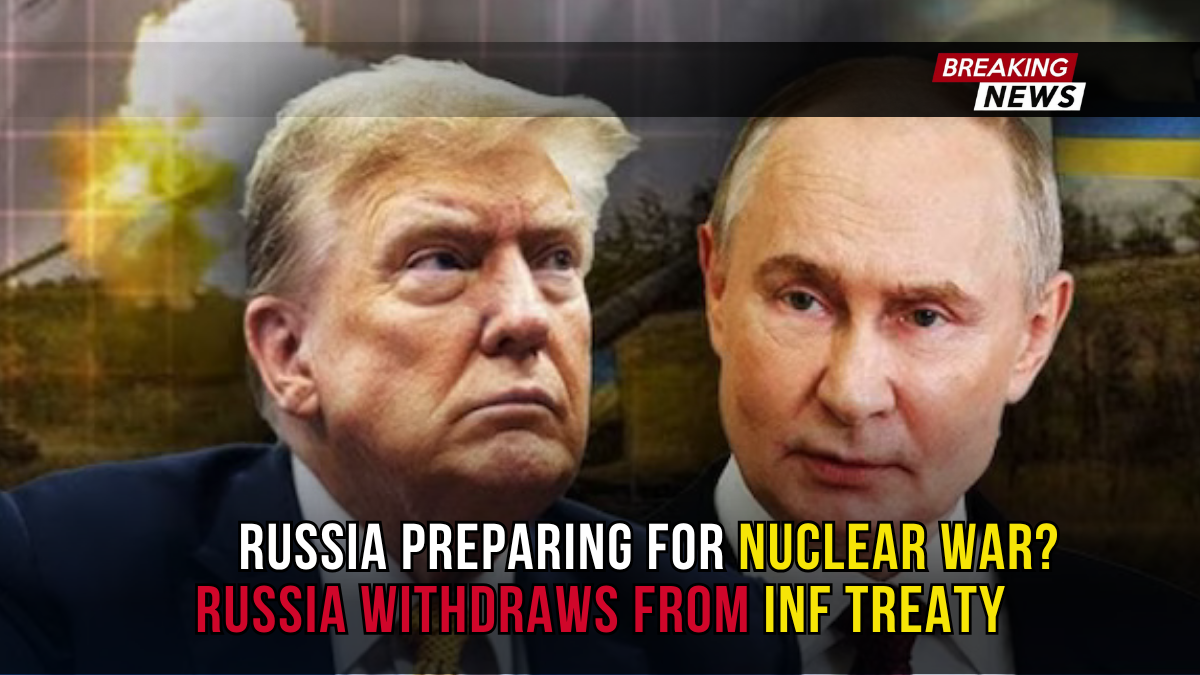In a dramatic turn of global geopolitics, Russia has officially withdrawn from the historic Intermediate-Range Nuclear Forces (INF) Treaty, citing the recent deployment of U.S. nuclear submarines near its borders as the final provocation. The move comes after former U.S. President Donald Trump announced the strategic positioning of two American Navy nuclear submarines in “appropriate regions,” a response to rising tensions and confrontational rhetoric from Russian officials. Originally signed in 1987 to curb the spread of medium-range nuclear weapons, the INF Treaty was a cornerstone of Cold War arms control. However, with both global powers now free from its constraints, the world may be entering a new era of nuclear uncertainty.

Summary Table: Russia Withdraws from INF Treaty
| Key Details | Information |
|---|---|
| Topic | Russia’s withdrawal from INF Treaty |
| Trigger Event | US deployed two nuclear submarines near Russian territory |
| INF Treaty Signed | 1987 by Ronald Reagan (US) and Mikhail Gorbachev (USSR) |
| Original Treaty Objective | Eliminate land-based nuclear missiles with range of 500–5,500 km |
| US Withdrawal | 2019, citing Russian violations |
| Russia’s Initial Response (2019) | Self-imposed moratorium on missile deployment |
| Current Russian Action (2025) | Complete withdrawal from INF Treaty |
| Main Justification | Alleged US weapon deployment in Europe and Asia-Pacific |
| Official Site for Updates | https://mid.ru/en (Russian Ministry of Foreign Affairs) |
What Was the INF Treaty?
The Intermediate-Range Nuclear Forces (INF) Treaty was a landmark agreement signed in 1987 between US President Ronald Reagan and Soviet leader Mikhail Gorbachev.
- The treaty banned all ground-launched ballistic and cruise missiles with ranges between 500 and 5,500 kilometers.
- It led to the destruction of nearly 2,700 missiles and helped reduce the threat of nuclear war in Europe.
- It was widely regarded as a cornerstone of Cold War arms control.
How the US Exited the Treaty in 2019
In August 2019, during Donald Trump’s first term as US President, the US officially withdrew from the INF Treaty.
- Reason cited: The US accused Russia of violating the treaty by testing and deploying a missile (the 9M729) that allegedly breached the agreed range limits.
- In response, Russia denied the claims but declared that if the US exited, it would also end its adherence.
- However, Russia announced a “unilateral moratorium”—a self-imposed pause on deploying medium-range missiles—as long as the US did not deploy similar systems.
What Triggered Russia’s Exit in 2025?
Fast forward to August 2025, the geopolitical environment shifted dramatically. US President Donald Trump publicly stated that he had ordered the deployment of two US Navy nuclear submarines to “appropriate regions” near Russia, as a counter to provocative remarks made by Russian officials.
- This was seen in Moscow as a strategic escalation.
- Russia responded by terminating the unilateral moratorium and formally withdrawing from the INF Treaty framework, despite the US already exiting it in 2019.
Russia’s Official Statement
According to a press release from the Russian Ministry of Foreign Affairs, the growing threat landscape in Europe and the Asia-Pacific region has invalidated the reasons for Russia’s restraint.
“Since the situation is developing towards the actual deployment of US-made land-based medium- and short-range missiles… the conditions for maintaining a unilateral moratorium… have disappeared,” stated the Russian Foreign Ministry.
This marked a clear shift in Russia’s defense posture.
Role of NATO and Medvedev’s Remarks
Former Russian President Dmitry Medvedev, now deputy head of the Russian Security Council, also made a strong statement following the withdrawal:
“This is a new reality all our opponents will have to reckon with. Expect further steps.”
- Medvedev directly blamed NATO’s anti-Russian policies for Russia’s actions.
- Though he did not specify what the “further steps” might include, his tone signaled a readiness to escalate militarily or strategically if needed.
Global Strategic Implications
This latest move has widespread implications:
1. Nuclear Arms Race Risk
- The dismantling of INF protocols reopens the possibility of land-based nuclear missiles being deployed in Europe or Asia, heightening the risk of miscalculation and nuclear escalation.
2. Europe as a Strategic Battlefield
- Countries like Poland, Germany, Romania, and others could once again become host to intermediate nuclear systems, echoing Cold War tensions.
3. Asia-Pacific Concerns
- The mention of the Asia-Pacific signals Moscow’s worry over US missile systems in Japan, South Korea, or even Taiwan.
US Reaction and Justification
Donald Trump’s decision to position nuclear submarines came shortly after Medvedev’s comments implying that a conflict between Washington and Moscow could no longer be ruled out.
The US has justified its submarine deployment as:
- A “deterrence measure”.
- Necessary in response to aggressive Russian rhetoric and global instability.
Russian Officials’ Past Warnings
Even before this escalation, Russian Foreign Minister Sergey Lavrov had hinted that Moscow’s moratorium was no longer sustainable.
In a December 2024 interview with RIA Novosti:
“The United States arrogantly ignored warnings from Russia and China and, in practice, moved on to deploying weapons of this class in various regions of the world.”
Lavrov’s statements now seem to have foreshadowed Russia’s eventual policy shift.
What Happens Next?
With both countries no longer bound by the INF Treaty, expect:
- Possible deployment of new missile systems by both sides.
- Re-militarization of strategic European and Pacific territories.
- Increased diplomatic friction at forums like the UN, G20, and NATO summits.
- Greater instability in the arms control landscape.
Frequently Asked Questions (FAQs)
1. What is the INF Treaty and why was it important?
The Intermediate-Range Nuclear Forces (INF) Treaty was signed in 1987 to eliminate ground-launched nuclear and conventional missiles between 500–5,500 km. It helped ease Cold War tensions, especially in Europe.
2. Why did the US withdraw from the treaty in 2019?
The US accused Russia of violating the treaty by developing prohibited missile systems (9M729). Russia denied the allegations.
3. Why is Russia officially withdrawing now in 2025?
Following the US deployment of nuclear submarines near its borders and rising tensions in Europe and Asia-Pacific, Russia ended its self-imposed moratorium and formally abandoned the treaty framework.
4. What are the risks of both countries being outside the treaty?
There is a higher risk of nuclear arms escalation, potential deployment of medium-range weapons in Europe/Asia, and increased chances of miscalculation.
5. Where can I get official updates on Russia’s position?
You can refer to the Russian Ministry of Foreign Affairs website: https://mid.ru/en
For More Information Click HERE




